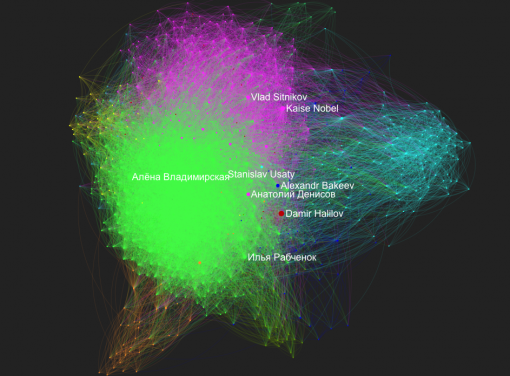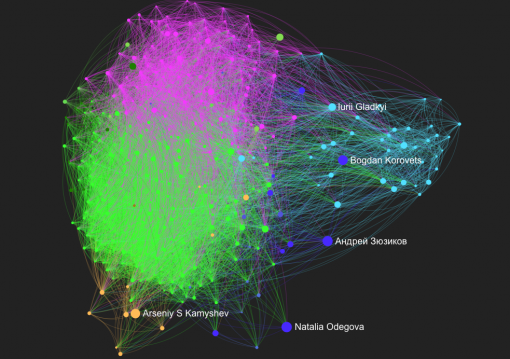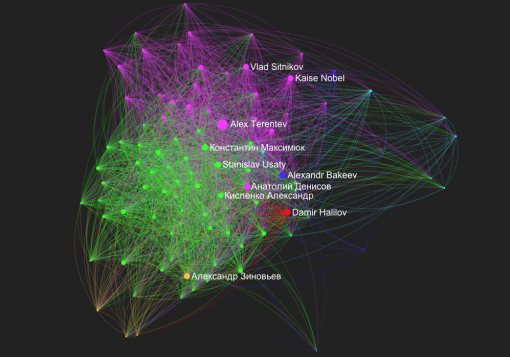Posted by Nodus Labs | May 28, 2012
Russian SMM Facebook Group Analysis
Social media marketing is a burgeoning field in Russia at the moment. In order to understand the structure of this community and the most influential people inside we performed a thorough analysis of one of the most popular Russian SMM Facebook groups called “Internet communication”. We used the approaches and methodology presented in our “Information Contagion” paper, some of which are outlined below.
Client: Zuckerman Pozvonit (a popular Russian SMM blog) and Way to Russia
Objective: Explore the community structure of Russian SMM professionals.
Result: click here to open our interactive network map of this group
Methodology
We first imported the Russian SMM Facebook group using netvizz Facebook app. The resulting graph encodes the members of the group as the nodes, and their Facebook friendships as the connections between them. It’s important to note here that for the better analysis the frequency of interactions between the nodes would have to be considered as well, however at the moment it’s not technologically possible to obtain this information in Facebook for larger group, because its API doesn’t really allow for such data to be exported. However, already knowing the social structure can tell us a lot about the potential informational pathways within the network.

Open the Group Visualizations in a New Window
The graph was then opened in Gephi graph visualization software. We then applied Force Atlas layout, which organizes the nodes that are more densely connected to each other than to the rest of the network into clusters and pushes the most connected nodes in the network apart. This helps obtain a more readable visualization of a network. We then used Gephi’s algorithms to calculate some key metrics, such as the average path (the average distance it takes to travel from one node to another in the network), distance (the longest path between the nodes), average degree (how many people in average each member knows within the group), betweenness centrality (a measure of influence that shows how often a node appears on the shortest path between any two random nodes in the network), and modularity (an algorithm that helps detect the communities of nodes that are more densely connected together than to the rest of the network). The resulting network was then visualized online using Sigma.Js tool.
The nodes that are shown bigger on the graph have a higher betweenness centrality – a measure of influence that shows how often a node appears on the shortest path between any two randomly chosen nodes in the network. In other words, the members of the group that are larger on the graph are the ones that are responsible for connecting different distinct communities together. They are the main hubs for information to spread through across the whole network and are also responsible for setting the agenda of the whole group.
Overall Network Structure
The group consists of 2423 nodes and 35860 connections. The largest community within the group is a sub-network of Russian SMM professionals (about 24% of the nodes and 22% of all connections), the second largest community within the group is a network of Russian (mainly Moscow-based) digital communication and internet marketing agencies (20% of the nodes and 21% of connections), the third largest community were the SMM and internet marketing professionals from Ukraine (12% of the nodes, 6% of connections), the fourth largest community were the SMM and marketing professionals from CIS – mainly Ukraine and Kazakhstan (8% of the nodes, 2% of connections), the fifth largest community were the internet professionals from Urals (6% of the nodes, 2% of connections). It’s important to note that the community structure was identified solely based on the nodes’ connectivity: the members that are already friends on Facebook and belong to the group are considered to be part of the same community if they are more densely connected together than to the rest of the network. It turned out, however, that the communities within the network were separated based on their geography mainly (except for the two largest communities that were segregated according to their professional fields: a more specific SMM community and the more general internet marketing and startups). Each of these communities is identified with a separate color on the graph. If you click the groups in the navigation below, you will be able to see the visualizations of each particular group and the most influential members within the groups (not within the whole network) will be shown larger on the graph.
click to open in a new window
The most influential people within the overall network are Damir Halilov (Green PR, St Petersburg), Kaise Nobel (Interactive Agencies Association), Stanislav Usaty (Stanlee marketing group, St. Petersburg), Vlad Sitnikov (Hungry Boys agency).
The network itself is very well interconnected. Most Facebook groups have at least 50% of “orphan” members (the ones that don’t have any friends who are also part of the group), however this group has only 10% of orphans, meaning that 90% of the group’s members belong to the same component and are connected to one another (on average you can reach any member of the group through a bit less than 3 people – the average path is 2.9). On average members have 29 friends (average degree: 29.6) who are already part of the network, which is a relatively high parameter for Facebook groups. Modularity is less than 0.4 (0.299), which means that the groups are quite well integrated into one another. Such high level of interconnectivity has certain advantages and disadvantages. The good thing is that the group can easily unify for a common action and there’s also a certain level of consensus within. However, it’s also closed to the new influences and might get too hermetic towards the outside world. A possible integration of an international SMM community or active recruitment of various corporate managers responsible for marketing and PR could help diversify the group.
Top 100 Influential People
The top 100 influencers are the members of the group that have the highest betweenness centrality, connecting the different communities that exist within the group together. The nodes that have the most influence within this Top 100 group are shown bigger on the graph. Those are the individuals who have the most influence and power in the network: Alex Terentiev (Mokita & Brain digital communication agency), Alexander Bakeev (R.May Consulting Group), Конастантин Максимюк (New Internet agency), Анатолий Денисов. As we can see these people are different from the ones listed above who were influential over the whole network. Rather, these are the individuals are are influential within the Top 100 group, sort of “grey cardinals” that are well-informed about the opinion generated in the core group and also have the means to influence it back.
click to see interactive image of the Top 100 network
Entrance Points
This group of people are the 15% of the total group members. They are the ones who have a good knowledge of the network, but are not the leaders within. Therefore they don’t have too much social pressure and would be more open than the most connected hubs in the network to share their knowledge with the others. They can be approached in order to find out more about the community, but not to really influence it (contrary to the people listed above). These are: Natalia Ogedova (SMM agency), Andrey Zuzikov (Facebook pages from Ukraine), Bogdan Dogovets, Arseny Kamyshev, Yury Gladkiy, Misha Mashtakov (a student from Moscow), Yury Afanasov (senior web communications specialist from VimpelCom), Yury Pidriz (internet image lab).

click here to see interactive visualization


